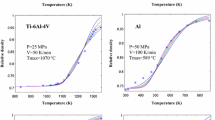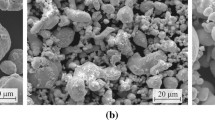Abstract
A compact gains strength in sintering through low-temperature interparticle bonding, followed by further strength contributions from high-temperature densification. On the other hand, thermal softening substantially reduces a compact's strength at high temperatures. Therefore, the in situ strength during sintering is determined by the competition among interparticle neck growth, densification, and thermal softening. Distortion in sintering occurs when the compact is weak. Most strength models for sintered materials are semi-empirical relations based on the sintered fractional density. These models do not include microstructure or sintering cycle parameters; thus, they do not provide guidelines for thermal cycle design to improve compact dimensional control. A strength evolution model is derived which combines sintering theories and microstructure parameters, including interparticle neck size, solid volume fraction, and particle coordination number. The model predicts sintered strength and when combined with thermal softening gives a good prediction of in situ strength. The validity of the model is verified by comparison to experimental data for sintered and in situ strength of bronze and steel powders.
Similar content being viewed by others
References
R. M. GERMAN, “Sintering Theory and Practice” (John Wiley & Sons, New York, NY, 1996). 125
Idem., “Particle Packing Characteristics” (Metal Powder Industrials Federation, Princeton, NJ, 1989).
I. H. MOON and J. S. CHOI, Powder Metall. 28 (1985) 21.
A. C. NYCE and W. M. SHAFFER, Inter. J Powder Metall. 8(4) (1972) 171.
V. A. TRACEY, “Modern Developments in Powder Metallurgy,” vol. 15, edited by E. N. Aqua and C. I. Whitman (Metal Powder Industries Federation, Princeton, NJ, 1985) vol. 15, 289.
G. A. SHOALES and R. M. GERMAN, “ Metall. Mater. Trans. A,” 29A (1998) 1257.
Idem., ibid. 30A (1999) 465.
M. F. ASHBY, Acta Metall. 22 (1974) 259.
K. S. HWANG, R. M. GERMAN and F. V. LENEL, Powder Metall. Inter. 23(2) (1991) 86.
S. G. DUBOIS, M. S. Thesis, The Pennsylvania State University, University Park, PA, 1995.
R. M. GERMAN and Z. A. MUNIR, Metall. Trans. B 6B (1975) 289.
Idem., Metall Trans. A 6A (1975) 2229.
C. M. SIERRA and D. LEE, Powder Metall. Inter. 20 (1988) 28.
S. H. HILLMAN and R. M. GERMAN, J. Mater. Sci. 27 (1992) 2641.
G. NEUMANN and G. M. NEUMANN, “Surface Self-Diffusion of Metals” (Diffusion Information Center, Bay Village, OH, 1972).
I. KAUR, W. GUST and L. KOZMA, “Handbook of Grain and Interphase Boundary Diffusion Data” (Ziegler Press, Stuttgart, Germany, 1989) vol. 1.
E. A. BRANDES, (ed.), “Smithells Metals Reference Book,” 7th edn.(Butterworth-Heinemann, Oxford, UK, 1992).
I. KAUR, W. GUST and L. KOZMA, “Handbook of Grain and Interphase Boundary Diffusion Data” (Ziegler Press, Stuttgart, Germany, 1989), vol. 2.
R. M. GERMAN, Mater. Trans. 42 (2001) 1409.
XIAOPING XU, WUWEN YI and R. M. GERMAN, J. Mater. Sci, to be published.
R. HAYNES, Metal Powder Report 46(2) (1991) 49.
Idem., Powder Metall. 14 (1971) 64.
E. NAVARA and B. BENGTSSON, Inter. J. Powder Metall. Powder Technol. 2(1) (1984) 33.
L. CIFUENTES and A. J. FLETCHER, ibid. 20 (1984) 51.
S. JAISWAL, A. J. FLETCHER and R. T. CUNDILL, ibid. 19 (1983) 51.
N. E. BAGSHAW, M. P. BARNES and J. A. EVANS, Powder Metall. 10(19) (1967) 13.
G. C. KUCZYNSKI, Trans. AIME 185 (1949) 169.
D. L. JOHNSON, Physics of Sintering 1 (1967) 22.
W. D. KINGERY and M. BERG, J. Appl. Phys. 26 (1955) 1205.
W. D. PILKEY, “Peterson's Stress Concentration Factors,” 2nd edn. (John Wiley & Sons, New York, NY, 1997).
J. L. JOHNSON, Ph.D. Thesis, The Pennsylvania State University, University Park, PA, 1994. Received 28 November 2000 and accepted 28 August 2001 126
Author information
Authors and Affiliations
Rights and permissions
About this article
Cite this article
Xu, X., Lu, P. & German, R.M. Densification and strength evolution in solid-state sintering Part II Strength model . Journal of Materials Science 37, 117–126 (2002). https://doi.org/10.1023/A:1013110328307
Issue Date:
DOI: https://doi.org/10.1023/A:1013110328307




